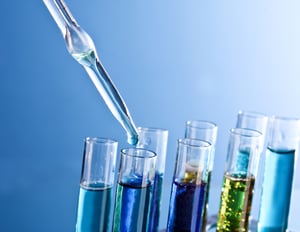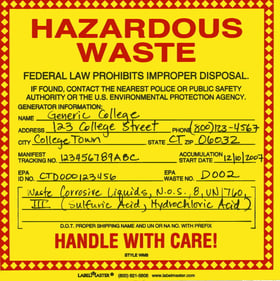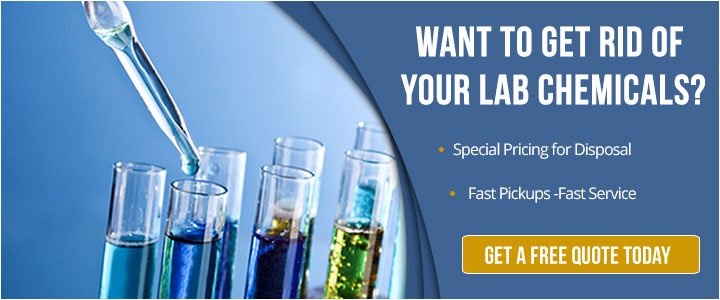Chemical waste is highly regulated by state and federal laws, and therefore must be disposed of safely and according to regulations.
Not doing so can result in disastrous consequences … for your lab, your community and the environment.
Whether the chemicals are expired, are no longer needed or present a hazard to your lab space, they must be discarded using proper procedures. The challenge, however, is that these procedures may vary based on the chemical.
Below are some general recommendations for how to dispose of lab chemicals.
Check The Safety Data Sheet
 The Occupational Safety and Health Administration (OSHA) requires that chemical manufacturers provide Safety Data Sheets (SDSs) for every hazardous chemical.
The Occupational Safety and Health Administration (OSHA) requires that chemical manufacturers provide Safety Data Sheets (SDSs) for every hazardous chemical.
SDSs, formerly known as Material Safety Data Sheets, are standardized documents that contain health and safety data about specific chemicals. They typically contain information such as:
- The properties of the chemical
- Any associated health and environmental hazards
- Protective measures lab technicians should take when handling the chemicals
- Any other safety precautions that should be taken for storing and transporting the chemicals
A SDS can provide valuable information about disposal as well. Though OSHA does not require “Section 13: Disposal Considerations” to be completed, if it is, this information can be very helpful. Items included in this section may include:
- A description of the proper containers to use for disposal
- Disposal methods that are recommended
- Properties of the chemical that may impact the disposal process
- Language discouraging or recommending a certain type of disposal process
If Section 13 is not completed, a facility can still find useful information in the SDS, including in Section 7 that provides an overview of handling and storage practices and Section 8 that provides an overview of personal protection recommendations.
Keep Chemicals Separated
Although it can be tempting to combine chemicals into one container for convenience, this should be avoided. Combining two different types of chemicals can create toxic vapors or cause a dangerous reaction such as a fire or explosion.
Rather than spend time researching which chemicals should not be combined, it is easier (and safer) to create a policy in which no chemicals are combined when in use or when preparing the chemicals for disposal.
Having proper procedures in place will discourage employees from making impromptu decisions about what wastes to combine as well.
Liquid waste should also be secured in leak proof containers. Check the SDS for any other storage rules, such as ventilation requirements or the maximum level storage containers should be filled to allow for vapor expansion.
Identify And Label
 Once you have separated your lab chemical waste, you must ensure it is properly identified.
Once you have separated your lab chemical waste, you must ensure it is properly identified.
All waste containers should include labels that identify the waste. Labels should not be vague, such as stating the chemical is corrosive. While this is valuable information, it still doesn’t identify the name of the waste.
Do not use abbreviations. Instead, spell out the name of the substance completely to avoid any confusion. Include any solvents in the container as well.
Hazardous waste, in particular, must be labeled according to state and federal laws. Proper labels should include information such as:
- The generator’s information
- An EPA ID or manifest tracking number
- The date accumulation in the container begins
- The composition and physical state of the chemicals
- Properties of the chemicals
More information on what to include on waste labels can be found in our article, How To Label Hazardous Waste. Free hazardous waste labels are available for download on our site as well.
Contact A Disposal Company
After preparing the chemicals for disposal, the next step is to work with a reputable disposal company, experienced in medical waste disposal, to remove your waste and transfer it to its final destination. Depending on the chemical, the disposal site may be a Treatment, Storage and Disposal facility (TSDF), a landfill or other location.
If you are unsure of how to dispose of lab chemicals in your facility, an experienced hazardous waste disposal program can ensure your waste is transported and disposed of following all relevant regulations.
When selecting a vendor, make sure the company is properly licensed and insured. This is important because even though a company will remove lab chemicals from your facility, you are still ultimately responsible for the waste until it is properly disposed of. These cradle to grave requirements are legislated under Resource Conservation and Recovery Act (RCRA).
A quality vendor will also:
- Identify wastes through sampling and testing
- Assist with preparing labels, manifests and other required paperwork
- Offer prompt pickups that work with your timeline
- Assist with packing waste to avoid costly fines
- Address any concerns you may have
A qualified disposal company should specialize in laboratory chemical waste disposal, as well as have in-depth knowledge of any regulations that apply to that chemical waste.
Our article, How To Choose A Hazardous Waste Disposal Transporter, further explores how to evaluate your goals and needs so that you can choose the best partner for your lab’s needs.


Comment